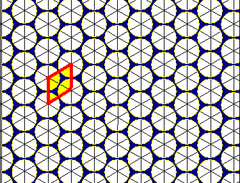Honeycomb conjecture


The honeycomb conjecture states that a regular hexagonal grid or honeycomb is the best way to divide a surface into regions of equal area with the least total perimeter. The conjecture was proven in 1999 by mathematician Thomas C. Hales.
Statement
Let Γ be a locally finite graph in R2, consisting of smooth curves, and such that R2 \Γ has infinitely many bounded connected components, all of unit area. Let C be the union of these bounded components.[1] Then
- .
Equality is attained for the regular hexagonal tile.
History
The first record of the conjecture dates back to 36BC, from Marcus Terentius Varro, but is often attributed to Pappus of Alexandria (c. 290 – c. 350). The conjecture was proven in 1999 by mathematician Thomas C. Hales, who mentions in his work that there is reason to believe that the conjecture may have been present in the minds of mathematicians before Varro.[2][3]
It is also related to the densest circle packing of the plane, where every circle is tangent to 6 other circles which fill just over 90% of the area of the plane.
See also
- Weaire–Phelan structure, a counter-example to the Kelvin conjecture on the solution of the similar problem in 3D.
References
- ↑ http://arxiv.org/pdf/math/9906042v2.pdf
- ↑ Weisstein, Eric W. "Honeycomb Conjecture". MathWorld. Retrieved 27 Dec 2010.
- ↑ Hales, Thomas C. (2001). "The Honeycomb Conjecture". Discrete and Computational Geometry. 25 (1): 1–22. arXiv:math/9906042
 . doi:10.1007/s004540010071. MR 1797293.
. doi:10.1007/s004540010071. MR 1797293.